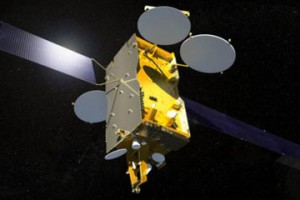Can We Repurpose Space Assets?
A lost Russian communications satellite has the potential to teach us about operations on the Moon.
The Russians launched a communications satellite, the Astrium Express-AM4, in August 2011. After a failure in its Proton launch vehicle (resulting in loss of contact and control), it was presumed lost. However, it survived and is trapped in a high-inclination orbit – a 20,000 by 650 km elliptical orbit (inclined 52° from the equator). Forcing it to operational geosynchronous (GEO) orbit would take most of its fuel, leaving the satellite with a very limited useful lifetime. The satellite was insured and payment has been collected on the mishap of the launch but the Russians have yet to decide on what to do with this wayward satellite circling Earth in the “wrong” orbit. Recently they indicated that there is enough fuel to conduct a controlled re-entry and descent, guiding the satellite to a safe, watery grave somewhere in one of the Earth’s oceans.
Must this be the fate of a newly orbiting space asset? True, it is in the wrong orbit for its original use as a commercial communications satellite, originally headed for 36,000 km above Earth to GEO, but what if instead it were repurposed? A company called Polar Broadband has an interesting idea about turning this mishap around and using it for a good purpose. Though not for its original users, they see a way to use this communication satellite for an assignment it is now suited to do. Polar Broadband envisions moving this satellite into an elongate orbit with a 24-hour period and apogee (high point) over its southern extreme (52° S) because a satellite in such an orbit can do service as a communications resource for Antarctica.
Antarctica!? It’s a remote barren landscape! True it is remote, but the population of this lonely continent swells greatly during southern summer when hundreds of scientists descend down under to conduct a wide variety of scientific studies. Although there are a few central bases (like McMurdo), communications with teams in the field can be spotty and unreliable. If this satellite could be positioned into a new orbit, it would appear in the sky for about 16 hours each day, allowing predictable, reliable communications from a variety of locations in Antarctica, including the difficult to access Amundsen-Scott South Polar Station.
An attempt to repurpose this satellite hardware appears to be a win-win for everybody. The National Science Foundation gets a new satellite asset for safe and productive communications with and operations in the Antarctic, Polar Broadband gets to sell this service to the NSF, and by giving a green light to this endeavor, the Russians will have benefited the international scientific community. There are no guarantees but the possibility for these rewards make the attempt worthwhile.
This experiment also holds relevance for future lunar exploration. What is being proposed for Express-AM4 is to create a reliable satellite system so that a distant base can communicate with its mission control for science and operations. Building and operating a working outpost at one of the lunar poles will require high bandwidth communication to remotely control robotic assets and return volumes of scientific and engineering data to Earth. Acquiring and gaining operational experience with polar communications is a good analog to doing so around the Moon, where we will require similar communications relays with long dwell times over the poles for access to polar spacecraft and robotic vehicles.
The Russians have said that the satellite has suffered extensive radiation damage as a result of its continued passage through the Van Allen radiation belts. But in its new guise, the satellite would receive far less radiation exposure than it would by going to GEO. Put to new use, this “lost” satellite could provide vital communications to and between scientific expeditions and assets in Antarctica and provide us with experience relevant to future operations on the Moon. A wayward communications satellite has presented us with an unexpected and rich opportunity.
/https://tf-cmsv2-smithsonianmag-media.s3.amazonaws.com/accounts/headshot/blog_headshot_spudis-300x300.jpg)

/https://tf-cmsv2-smithsonianmag-media.s3.amazonaws.com/accounts/headshot/blog_headshot_spudis-300x300.jpg)